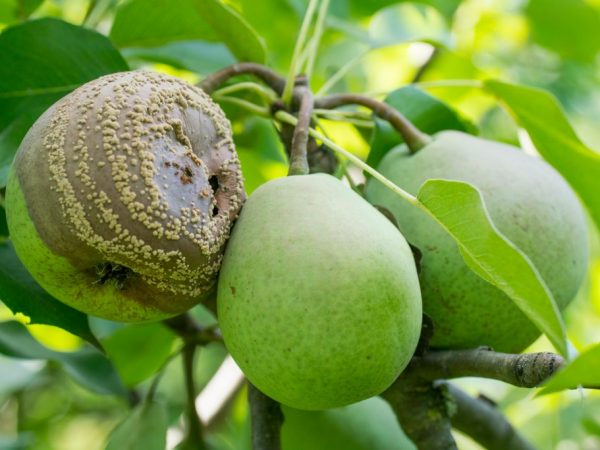Causes of rotting pears on a tree
Pears often rot on the tree before they are fully ripe. The reason for this is fruit rot - a fungal disease that is spread by spores in windy and rainy weather.

Causes of rotting pears on a tree
Old selection
There are few reasons why pears rot and crack. Several decades ago, a rotting pear grew in many gardens. The process of decay is genetically incorporated into it: closer to ripening, the fruits become soft. Rot is visible at the root tip and spreads quickly from the inside.
Trees grown on a rootstock of rotting also have a genetically inherent process of rotting right on the tree during maturation. Such varieties are either harvested from the garden, or the fruits are removed in an unripe state. Unripe fruits are used for preservation, winter compotes. After removal, they are placed in a darkened place and then consumed fresh.
Moniliosis
Modern varieties are bred on the rootstock of quince, so they do not rot by themselves. Fruit ripens well before being removed without losing flavor. After picking, pears can lie for several months. Late varieties can be stored until spring. But this is real if the gardener looks after his garden, cleans it and reacts in time to the first signs of fungus. Otherwise, fruit rot can infect pears and other fruits.
Moniliosis affects only inflorescences and fruits, without affecting the trunk and leaves itself. In addition to pears, apples, apricots, cherries and plums are also susceptible to infection. The fungus tolerates cold well. The main ways and reasons for its spread:
- leaves and branches in the garden uncleared in autumn;
- unharvested rotten fruits;
- high humidity and lack of light in the garden;
- periods of prolonged rains;
- through insect pests.
Moniliosis does not manifest itself for a long time. Spores are transferred in windy weather from affected sources (last year's fallen leaves, fruits not harvested from trees) directly to healthy fruits.
During the ripening of the fruit, insects and worms are also capable of carrying disease spores into the fruit. The missed preventive treatments of the garden from pests contribute not only to spoilage of fruits, but also to spoilage of the entire crop.
Signs of moniliosis
During the spring frost, the color on the trees fades and turns brown. This is the first sign of infection. When damaged by frost, the color crumbles to the ground, but when damaged by rot, it does not. If this step has been missed and proper measures have not been taken to control the fungus, there is a high probability of contamination of healthy plantings.
Later, the infection manifests itself during the ripening of the fruit. At first, small brown spots appear on almost ripe fruits. In a short period of 1-2 days, the spots increase noticeably in size. Light yellow circles are clearly visible on the skin. The flesh underneath is soft and watery. The fruit gradually rots completely. The disease quickly spreads to healthy fruits - which is why pears rot on the tree.
Treatment

Infected fruits must be removed immediately.
Today, there is no cure for fruit rot that can permanently save the gardener from this problem. If there is moniliosis in the garden, they carry out:
- disposal of affected fruits: they are buried in the ground to a depth of at least 1 m;
- removal of affected inflorescences and treatment of the garden with a fungicide;
- insecticide treatment twice a year;
- fallen branches and leaves are collected and burned - this is the source of the spores of the fungus.
In the spring, spraying with 1% Bordeaux mixture is carried out until the buds swell. Re-processing is carried out after the end of flowering. The third treatment is carried out after 2 weeks.
During the growing season, spraying with Fitosporin, Folikur or other available fungicides is carried out. The last processing is carried out no later than a month before harvesting.
If in the previous season there was moniliosis on the pear, in the spring they must remove all the old dried branches, clear the tree. The fungus does not tolerate direct sunlight and dies quickly.
The soil under the tree, on which there were spoiled fruits, is carefully dug up. In autumn, the tree is treated with ammonium sulfate, silite or urea.
Prophylaxis
Prevention of moniliosis is reduced to observing the rules for caring for garden trees. Gardening is done seasonally.
Spring-summer works:
- clearing trees from branches, pruning and shaping the crown;
- applying fertilizers to the trunk circle;
- whitewashing the trunk;
- spraying with fungicides and insecticides.
Autumn works:
- harvesting rotten fruits on the ground and on branches;
- pruning dried pruning shears;
- autumn feeding;
- processing wood from hibernating pests;
- whitewash.
To prevent fruit rot and other fungal diseases in the fight against insects, spraying with a solution of copper sulfate is carried out. Copper is an essential element for healthy garden growth. Copper sulphate is more aggressive than Bordeaux mixture, so following the manufacturer's instructions is mandatory.
Spring and autumn events do not take much time and do not require the use of expensive drugs. Timely treatments cannot guarantee 100% protection against garden diseases, but significantly reduce its likelihood.
Conclusion
Compliance with a set of measures protects pears and the garden from pests and diseases. It is better to spend more time on prevention than to heal the garden for a long time and lose the crop.


